
In 1972, Hawkwind’s Silver Machine was aired on TOTP. Or blasted, more like. It sounded like nothing else I’d ever heard. A driving rock riff emerging through the swirling aural mist of the intro and powering into orbit. It grabbed 14-year-old me by the penny round collar of my Ben Sherman shirt. It made me want to be in a band. It made lots of us want to be in a band.
The first piece of the puzzle
Fast forward 12 years. Anyone walking towards the towering edifice of Wharncliffe Viaduct, Hanwell, in late 1984 would’ve wondered at the new graffiti painted high up on the top wall. One word, very neatly done in a kind of copperplate style with interlocking characters and decent kerning.
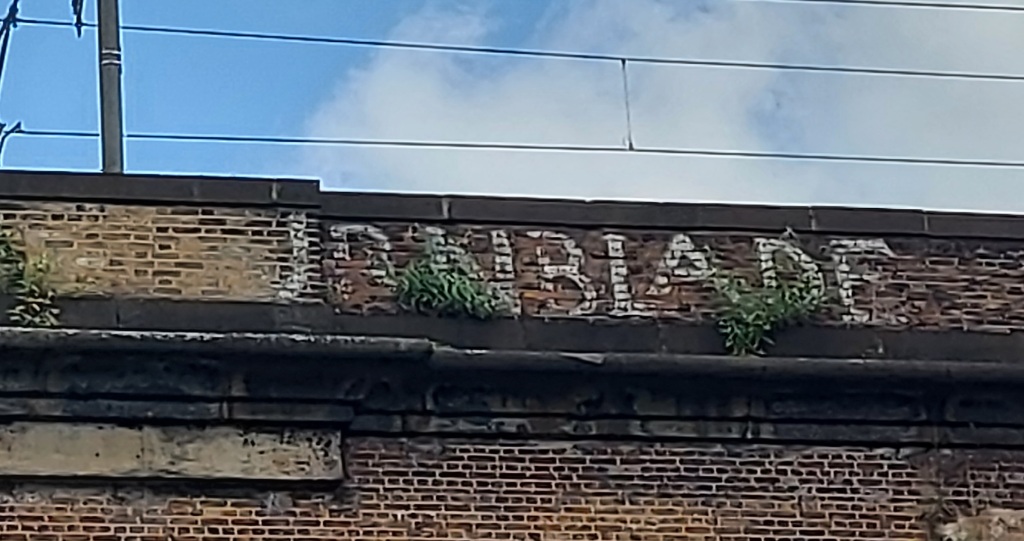
By the time I first saw it, 30 years later, it had faded to an enigmatic JRNBLADE. I often wondered what JRNBLADE meant. I also often wondered how the hell it got there. I pictured some brave artist dangling in a makeshift sling 20 metres or so up in the air, perhaps in the dead of night. I resolved to find out more.
The genesis of the band
MOURNBLADE are a West London heavy metal band formed in September 1982. Dunken Mullet and Richie Jones shared an interest in science fiction, particularly that of Michael Moorcock, and named their band after a sword from his best-known stories. Mournblade is a great name for a sword (and a pretty good name for a band). It must’ve been a special day when Moorcock gave them his official blessing to use the name.
Dunken (vocalist) and Richie (guitar) were also into the space rock of Hawkwind and The Pink Fairies, and the heavy metal rock ‘n roll juggernaut that was Motörhead. In the space of a few months they wrote a set’s worth of songs, and recruited Derek Jasnock on keyboards, Clive Baxter on bass and Aladdin Waz Jarrah on drums. Aladdin was replaced by Tim Boyd before their first gig, at Ealing College Student Union in 1983.

In the early days, performances involved Mullet making up to 14 costume changes and selecting from a variety of props, including a 2.5-metre wooden sword, a life-size Victorian doll called Victoria, a decaying World War I soldier’s mask, a devil suit with cape, and last but definitely not least, a space helmet – a gold-painted crash helmet with LED lights and a laser beam.
Comings and goings
For a spell in 1983, Mournblade’s keyboard sound was augmented by Steve Ellis on synthesizer. And at the risk of sounding Spinal Tappy, the band got through rather a lot of drummers in those early years. Tim Boyd was replaced by Nigel Tubb in 1983, who left to be replaced by Jeff Ward and then Chris Jones in 1985. Shortly after that, Garry “Magpie” Bowler was given the job and has been doing the tricks with the sticks ever since (he also recently released a solo LP).
Getting a settled line-up is never easy, and I know from experience that auditions can be fraught, especially with drummers who may take hours of precious rehearsal time to get their kit set up. Never ever came across the likes of this though…

Other changes around this time were bass player Clive Baxter leaving and Richard Goddard joining for a while, before Paul “Blacken” White took over. Like Magpie, White is still with the band, as is Stephen Loveday, an additional guitarist who was the final piece of the jigsaw.
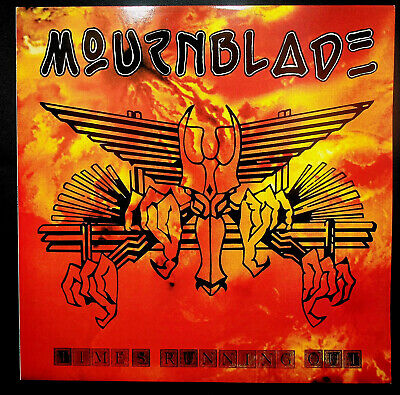
Time’s Running Out
1985 seems to have been an eventful year. In addition to the changes in personnel, Mournblade also signed to Flicknife Records and released their first LP, Time’s Running Out. An intense touring schedule followed, with more than 400 performances around the UK over the next few years. Mournblade also played many free festivals, including Stonehenge in 1984 and 1985. I marvel at the stamina and self-belief they must’ve had to keep going.
Despite all the hard work and their links to the likes of Hawkwind, Mournblade’s initial success faded, though they did keep a core following in London, South Wales and the Midlands. They also had a full-colour feature in Kerrang! who bestowed on them the mixed-blessing and oft-quoted ‘Future of British Heavy Metal’ plaudit.
Mk 1 – end of an era…
In 1986, Derek Jasnoch left, and Peter Lazonby took over on keyboards. The following year, Lazonby left too. But the biggest change in 1987 was Richie Jones leaving the band.
…Mk 2 – start of a new era
The four remaining members of Mournblade: Dunken Mullett, Stephen Loveday, Garry Bowler and Paul White, decided to do away with keyboards and costumes. The sound became leaner and rawer, creatively refreshed. White’s distorted and immense 8‑string Rickenbacker bass sound took over the space where the keyboards once were. Mournblade were now said to be in the latter part of the new wave of British heavy metal.
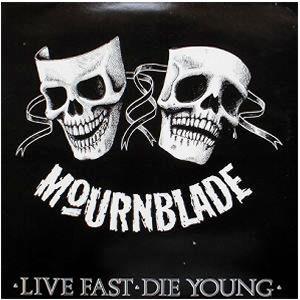
Live Fast Die Young
The release of Mourblade’s second album, Live Fast Die Young, in 1989, was followed by tour after tour of the UK and Europe. One UK tour had 36 shows in 43 days, with the band living and travelling together in the same bus throughout. At this time, Mournblade headlined at the London Hippodrome, a show that was broadcast on MTV, as well as appearing with major acts such as Motörhead, Doctor and The Medics, Zodiac Mindwarp, Hazel O’Connor and The Enid.

The touring schedule took its toll, contributing to the band splitting up at the end of 1989.
The hiatus
Mullett has a strong singing voice that doesn’t sound pretend-American. He sings with an English accent. Early in 1990, he teamed up for a while with ex-Pistol Glen Matlock and at-the-time-still-Damned Rat Scabies. A few bands later he moved to New Zealand. Stephen Loveday went into music production (I think). Garry Bowler carried on drumming, helping out heavy metal heroes like Motörhead. No idea what Paul White did, but he certainly was and still is a mighty fine bass player.
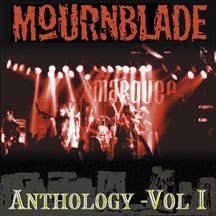
The Resurrection
But the fans never went away. When Anthology Part 1, a compilation of live and demo recordings, was released in 2011 it reminded everyone just how good Mournblade were live. The following year, popular demand persuaded Mournblade to reform. After 24 years apart they had only three days’ rehearsal before playing at the Heavy Metal Maniacs Festival at Hoorn, in the Netherlands. Musician and film director Henrieta Tornyai made a documentary of the show, Mournblade – The Resurrection.

Mournblade then released two further albums: Live & Loud, from the reunion show rehearsals; and Live in Holland, a double DVD of the documentary and reunion show.
Time’s Running Out again
In 2013, the original Mk 1 line-up decided to re-visit the 1985 Time’s Running Out album. The original six tracks were re-worked and re-recorded, along with three songs from Ein Heldentraum, a demo cassette from 1986.
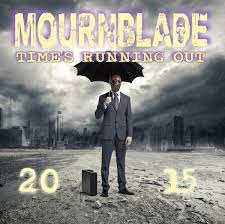
Time’s Running Out 2015 was released in September 2015, initially on CD and then on vinyl, including a short run on translucent vinyl.
Mystery and legacy
How the MOURNBLADE graffiti got on the viaduct remains a mystery, though there are whispers that two men may have climbed one of the piers at 5am one dark, foggy November morning. It’s possible they hung over the edge some 25 metres up and painted the wording with a bucket and brush. If by any chance they were having a quick track-side break between painting stints, there would’ve been the danger of being sucked into the side of one of the InterCity 125 trains that whizzed past. The painting took maybe 30 minutes. Or maybe not.
Rumours that the two then climbed back down and had a Full English at a café in Hanwell are completely unsubstantiated.
Some of us think the graffiti should be restored and listed. And it’d be great to see the band play at the Hanwell Hootie – the home of Loud. Guess it’s too late for this year’s Hootie in the Meadow on 19 September. But some time, maybe next year, it would be great to see and hear them underneath the Wharncliffe wonder in Brent Meadow.

Recordings
This list doesn’t include all the many demos and official/bootleg live recordings doing the rounds in the early years. For more details, including track listings, see the links at the end of this article.
- Time’s Running Out 1985 mini LP
My favourites on this album are In The Arms Of Morpheus, Sidewinder and Titanium Hero.
- Live Fast Die Young 1989 LP
Available on iTunes. For me, the best of a great bunch are Burning Ambition, a slow burner with a hypnotic rolling bassline, and Crash ‘n Burn and Off The Rails, both of which have great guitar hooks that pervade throughout and get under the skin.
- Anthology Volume 1 2011 CD live/demo compilation
Available on iTunes. Includes four tracks from Time’s Running Out. The other tracks are from demo recordings, of which Servants Of Fate, Science Of Fiction, Eternal Champion and The Sorcerer stand out.
- Live & Loud 2012 live LP
Available on iTunes. Includes a damned neat cover of The Damned’s Neat Neat Neat.
- Selling Your Ass (for the Big Time) 2012 single
Available on iTunes. A full-pelt pop at the music industry with a killer running riff. The lyrics give Have A Cigar a run for its money, especially the menacing growl of “Sign here, sign here, sign here, sign here. And here, and here, and here…”
- At the Heavy Metal Maniacs Festival 2012 live LP
Available on iTunes.
- Time’s Running Out 2015
A re-working of the original 1985 album, with the addition of the following from the Ein Heldentraum demos: Science Friction, The Stairway and Desolation
Available here: NNP -015CD/VNL – Mournblade – Time’s Running Out 2015 | Non Nobis Productions (bandcamp.com)
- Drummer Garry Magpie Bowler has just released an LP: Dancing With The Devil
https://recordstoreday.co.uk/releases/rsd-2021-drop-2/magpie/
NB Take care when looking up Mournblade on iTunes. The 2006 EP Mangled Lies is by a different Mournblade, a US thrash metal band.
More info and pics…
- There’s tons of interesting stuff on Facebook: Mournblade – Home | Facebook
- They’ve got a Wikipedia page too: Mournblade (band) – Wikipedia
- Mournblade’s website is down at the moment: www.mournbladeband.com
- Mournblade are on Twitter but aren’t very active there: https://twitter.com/MournbladeUK
- A short and sweet summary: Mournblade – Band Biography – Diskery
Sound and vision…
- The Resurrection Documentary: https://www.youtube.com/watch?v=toRIzQJIjrk
- Sidewinder live: https://www.youtube.com/watch?v=yxdzyLisVrU
- Dirty Black Leather, Wet White Lace: self-released VHS 1985
My thanks to Mournblade for permission to use images from the band’s Facebook page.
You must be logged in to post a comment.